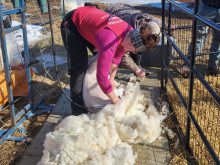LEDUC, Alta. – Alberta hog producers need their own specialized marketing company and their own pork brand if they’re to survive.
Those are two recommendations made in a recent proposal to help the industry as it struggles with high feed prices and low hog prices.
“This is indeed a difficult situation and we didn’t get here overnight. There is no silver bullet,” said Jerry Bouma, project manager with Toma & Bouma Management Consultants, which the industry hired to develop a plan to help producers find a path to prosperity.
Read Also

Charges laid after cattle theft
Saskatchewan RCMP lay two charges against a man after six cattle went missing.
A new Alberta marketing company would be able to invest with joint venture partners, seek out specialty markets and develop relationships with key customers, Bouma told about 250 producers at a meeting, during which the proposal was presented.
“This is not going to be easy. The risks are high, but the risk of ‘keep doing what we’re doing’ are even higher.”
He said Alberta hog producers are losing too much money trying to compete in the American market with a high Canadian dollar. Developing new niche markets is key to surviving in a competitive industry, he added.
Alberta’s image of clean air and high food quality and safety standards should also be exploited to the producers’ advantage. Producers are already meeting high standards of food safety, animal health, animal care and environmental protection. These quality standards should be recognized and promoted as reasons consumers should buy Alberta pork.
At the moment, consumers don’t know if the pork bought in the local grocery store is from the producer down the road or imported from the United States.
Rocky Mountain House producer John Middell said branding is a difficult concept for producers who spend most of their time in barns raising pigs.
“We ship pigs. Even though we call ourselves pork producers, it’s hard to get beyond that,” said Middell, who believes most producers are willing to look at industry changes.
Producer Bryan Perkins said he and his colleagues have done a poor job building relationships between producers, processors and customers. Hog producers talk about the need to build relationships, but it’s one of the jobs that seems to never get done, he added.
Perkins likes many of the proposals presented, but said he needs to know more details about how some of the recommendations would work.
The report also recommended the hog industry work more closely with processors to create an adequate volume of branded product and have a more integrated marketing system with producers.
Taking a close look at how packing plants can meet customer requirements and priorities is also a key plank in the proposal.
Bouma said working with Olymel, the largest pork processor in the province, is key to the success of the program.
“The real key will be Olymel. The question is how that unfolds.”
Western Hog Exchange, the marketing arm of Alberta Pork, wants to buy 49 percent of Olymel to create an integrated pork industry in the province.
Last year, Alberta agriculture minister George Groeneveld challenged the province’s beef and hog industry to develop a plan beyond ad hoc payments.
Bouma said his company’s recommendations aren’t quick fixes and need government transition payments to move forward.
“The industry is in distress. It will require transition support to move through Death Valley.”
He said Alberta producers also need to explore the viability of carbon credit offset programs targeted specifically to the production of feed grains. Producers may be able to receive credits from energy companies for growing feed grain. Grain producers need an incentive to grow feed grain, Bouma added.
Creating new feed grain policies is not a sexy sell, said Alberta Pork manager Paul Hodgman.
“Building a feed grain market is hard work. It’s not glamorous, but it’s essential to our industry,” he said.
Hodgman said the presentation wasn’t a single, simple solution to creating a profitable hog industry. Changes will take time and a commitment from more than just producers.
“As an industry we need to pull together in a really collaborative way or what will change?”
A final report will be presented at the hog producers’ semi-annual meeting in June. It’s hoped a plan to move forward will be in place by fall.
“The hard work is yet to come,” Hodgman said.
















